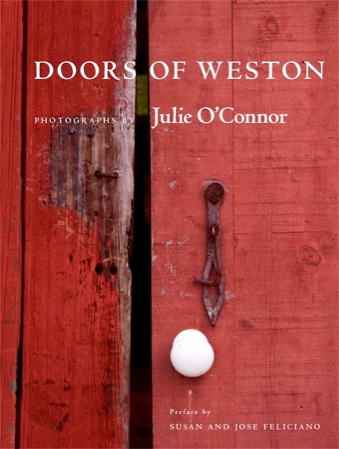Doors of Weston

A Glimpse through the Doors of Weston History
What is now Weston was once the home of the Aspetucks, a clan of the Paugussett Indians descended from the native peoples that roamed the area for thousands of years. The land was covered with vast forests then, good for hunting deer, raccoon, and bear. The rushing rivers teemed with trout and bass. And, along those rivers, land had been cleared to grow maize, squash, beans, and root vegetables.
The first Europeans in the area settled in Fairfield, in 1639. The town expanded quickly and settlers soon began laying claim to land to the north. Fairfield bought a large parcel from the Aspetucks for £30 in colonial currency and some trucking cloth, and named it North Fairfield. This was the area that a century later would become Weston and Easton.
In 1671, Fairfield formally divided the land into Long Lots that extended northwesterly and parallel to a newly established "Mile Common." The Mile Common extended "for a day's ride" along what is today Old Redding Road—bringing the border of Fairfield to the lower boundaries of Danbury (today's Cross Highway in Redding). The lots were long, narrow parcels varying in width from roughly fifty feet to 1,200 feet, their size adjusted to the status of the owner. The names of some of these "Outlivers," as these families became known, remain familiar: Coley, Sherwood, Wakeman, Burr, and Bradley.
In the subsequent years of setting up homes, farms, and small businesses, Weston's Outlivers found it increasingly inconvenient to return to the center of Fairfield for supplies and for their obligatory attendance at church services—particularly in winter. The area's first steps toward autonomy came on the religious front. Several independent ecclesiastical societies were launched in the mid-18th century, including the Norfield Society in 1757 and the Episcopal Society of North Fairfield in 1762. Soon after, Nathan Morris, David Godfrey, and David Coley held the founding meeting of the Norfield Society and they summoned Samuel B. Sherwood to be Norfield's first minister. Sherwood would later become well known for his fiery patriotic sermons that inspired volunteers to join the local militia during the Revolutionary War.
Political independence for the North Fairfield Parish came in 1762 when the Connecticut General Assembly formally divided it from Fairfield. A generation later, in 1787, the Legislature re-joined the parishes centered around the Norfield and North Fairfield Societies, turning them into a single, new town named Weston. But both parties chafed at this artificial union: distances between their centers were great, and each had its own character. Each side wanted to be rid of the other. Finally, in 1845, the General Assembly agreed to separate Weston into two towns: Weston and Easton.
After the division, Weston's residents continued to make their own way, living from the land and creating new businesses. The town's most famous cash crop was onions, which became particularly well-known when they were among those used to supply the troops fighting in the Civil War. But given the rocky nature of the area, suitable farmland remained in short supply.
Business would drive the next stage of Weston's growth. The rapidly flowing waters of the Saugatuck and Aspetuck generated power for the operation of blacksmith shops, saw mills, and a gristmill (now the Cobbs Mill Inn). They also provided power for a hat factory, a textile mill, a button factory, several tanneries, a toy factory, and the famous G.W. Bradley Edge Tool Company, which, at its peak in the 1860's, employed 100 men. But these enterprises couldn't keep up with the great sweep of the Industrial Revolution. Steam replaced water as a source of power, and industry moved on to Danbury and Bridgeport, cities that had access to the railroad. Weston's population fell from a peak of 3,000 in 1830 to only 830 citizens in 1910, becoming one of the poorest towns in Connecticut in these years of decline.
Fortunately, the Roaring 20's and the glitz and glamour of New York City came to the town's rescue. The advent of the Model A in 1928 and the building of the Merritt Parkway in the 1930's made it possible for people to come to Weston to escape the bustle and noise of New York. Weekend getaways soon became permanent homes for people such as John Held, Jr., known for his caricatures of the flapper era and his hand-forged iron signs that still grace the town. Weston soon welcomed numerous writers, artists, performers, and intellectuals: Eva Le Gallienne, the actress, Lawrence Langner and Armina Marshall, the well-known theater couple, James Daugherty, whose murals grace our Town Hall, Catherine Ordway, the conservationist, George Balanchine, the famed choreographer, and his wife, Tanaquil LeClerq, actresses Betty Davis and Mariette Hartley, entertainers such as Eartha Kitt and Rodney Dangerfield, and Supreme Court Justice John Marshall Harlan II to name just a few. Among today's well-known citizens are Keith Richards, Christopher Plummer, Erica Jong, James Naughton, John Siegenthaler, Frank Converse, Maureen Anderman, and Jose Feliciano.
Almost one quarter of the town is permanently devoted to open space, including Devil's Den Preserve with its 20-mile trail system, sixteen preserves of the Aspetuck Land Trust, and the Katherine Ordway Preserve, with its trails and arboretum. Weston schools have consistently ranked among the highest in the nation and third in the state of Connecticut.
The character of Weston has been built over these couple of centuries by multiple generations of wonderful, hardworking families. Helping each other and their neighbors, they have built the vibrant and thriving community that is Weston today. Independent-minded as their Outliver forebears, today's Westonites cherish their freedom, privacy, and local democracy.
— Adapted from the essay "A Glimpse Through Weston History," by Karin Giannitti, in Doors of Weston, by Julie O'Connor, fine art photographer and photojournalist. The book, which features 177 color photos and thumbnail sketches of Weston history, is available from the Weston History & Culture Center.
